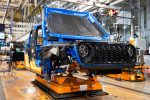
Which Cars Will Face the Heaviest Tariffs Under President Trump’s New Auto Policy?
President Trump’s latest trade move—a sweeping 25% tariff on all foreign-built vehicles and parts—has sent a clear message: build in America, or pay the price. Set to take effect April 3, the tariff applies to every vehicle and part manufactured outside the U.S., regardless of whether it’s built in Canada, Mexico, or overseas. For many automakers, that’s a significant hit—and for consumers, it could mean noticeable price hikes at the dealership.
“If you build your car in the U.S., there’s no tariff,” Trump declared. But as modern car production often spans continents, the new rule exposes certain models and brands more than others. So, which cars will be hit hardest?
The Models Facing the Heaviest Tariffs
Some of the most popular and enthusiast-loved vehicles in the U.S. could take the biggest tariff hit due to extremely low domestic content. These cars are often fully built overseas, with minimal U.S. manufacturing input, making them especially vulnerable under Trump’s new policy. Among the most exposed are the Mazda Miata, Hyundai Elantra N, BMW M3 Sedan, Subaru BRZ, and Toyota’s GR86 and GR Corolla—all of which have just 1% domestic content. These cars rank near the bottom of the 2024 American-Made Index, and all are expected to face steep price hikes due to the new import duties. Affordable performance models like the Miata, GR86, and BRZ, already niche-market cars, could see demand fall if tariffs push their prices out of reach.
Automakers Most Exposed to U.S. Tariffs
Data from Wards Automotive, Barclays, and Axios reveals just how reliant some brands are on foreign production for their U.S.-sold vehicles. The less a brand manufactures domestically, the more exposed it is to Trump’s tariff policy.
Automaker
Automaker Origin
Share of U.S.-Sold Vehicles Made in U.S.
Volvo
Sweden
13%
Mazda
Japan
19%
Volkswagen
Germany
21%
Hyundai-Kia
South Korea
33%
Mercedes
Germany
43%
Toyota
Japan
48%
BMW
Germany
48%
GM
U.S.
52%
Nissan
Japan
53%
Subaru
Japan
56%
Stellantis
Multinational
57%
Honda
Japan
64%
Ford
U.S.
78%
Rivian
U.S.
100%
Tesla
U.S.
100%
Brands like Mazda, BMW, and Volvo—with less than half of their U.S. lineup built stateside—are positioned to feel the brunt of these tariffs. Japanese automakers, in particular, are highly exposed, with car exports making up over 28% of Japan’s shipments to the U.S. in 2024.
GM and the North American Loophole
Even some U.S.-based automakers aren’t in the clear. General Motors, for example, still builds roughly 40% of its vehicles in Mexico and Canada, making it vulnerable to billions in tariff costs. Analysts at JPMorgan estimate GM could take a $14 billion earnings hit, even though the White House has suggested some vehicles built under the USMCA (United States-Mexico-Canada Agreement) may receive temporary exemptions.
That process, however, remains undefined. Until then, GM’s reliance on neighboring countries keeps it on shaky ground under the new policy.
Cars Best Positioned to Avoid Tariffs
Tesla, with its entire lineup built in the U.S., tops the list. The Model 3, Model Y, and even the newly launched Cybertruck all exceed 80% domestic content. While Tesla still imports some parts from China—prompting CEO Elon Musk to note that the company is “not unscathed”—it’s better positioned than almost any other automaker.
Ford’s Mustang GT, especially in automatic trim, also avoids heavy tariffs with an 80% domestic content score. Honda’s Passport, Jeep’s Wrangler, and Volkswagen’s ID.4 similarly carry high U.S.-made credentials.
Most American-Made Vehicles (By Total Domestic Content)
Tesla Model 3 Performance – 87.5%
Tesla Model Y Long Range – 85%
Tesla Model Y – 85%
Tesla Cybertruck – 82.5%
Tesla Model S – 80%
Tesla Model X – 80%
Ford Mustang GT (Automatic) – 80%
Ford Mustang GT 5.0-liter – 80%
Ford Mustang GT Coupe Premium – 80%
Honda Passport AWD – 76.5%
Honda Passport Trailsport – 76.5%
Jeep Wrangler Rubicon – 76%
Jeep Wrangler Sahara – 76%
Volkswagen ID.4 AWD 82-kWh – 75.5%
Chevrolet Colorado 2.7-liter – 75.5%
GMC Canyon AT4 Crew Cab 4WD – 75.5%
GMC Canyon Denali Crew Cab 4WD – 75.5%
Chevrolet Colorado LT Crew Cab 2WD 2.7-liter – 75.5%
Chevrolet Colorado Z71 Crew Cab 4WD 2.7-liter – 75.5%
Volkswagen ID.4 RWD 96.2-kWh – 74.5%
Volkswagen ID.4 RWD 82-kWh – 74%
Honda Odyssey – 74%
Honda Ridgeline – 74%
Honda Pilot – 74%
Lincoln Corsair – 73.5%
What This Means for Consumers
If you’re shopping for a vehicle in the coming months, expect to see price increases on foreign-built vehicles, especially as current dealer inventories run dry. Dealers have been quietly stockpiling imported models, but that buffer will only last a few months. By summer, the full effect of the tariffs is expected to ripple through pricing.
Performance cars, luxury models, and budget-friendly imports from Japan and Europe will likely take the biggest hit—while American-made vehicles could become more price-competitive by comparison.
Global Reaction and Political Fallout
Japan has not taken the news lightly. Prime Minister Shigeru Ishiba stated his country is considering “all options” in response, pointing out that Japan is already among the largest investors in U.S. manufacturing.
“There is a question whether it makes sense to apply uniform tariffs to all countries,” Ishiba told parliament. Meanwhile, shares of Toyota, Nissan, and Honda all fell immediately after the announcement, with Hyundai and Kia also taking a financial hit.
The Bottom Line
President Trump’s tariff policy marks a significant shift in America’s automotive trade stance—and for some automakers, it’s a wake-up call. Vehicles built overseas, especially those with little to no domestic content, will face the heaviest financial penalties, leading to higher prices and potential declines in sales volume.
For brands already invested in American manufacturing, this is a moment of opportunity. For everyone else, it’s time to make tough decisions about where—and how—they build cars for the American market.


